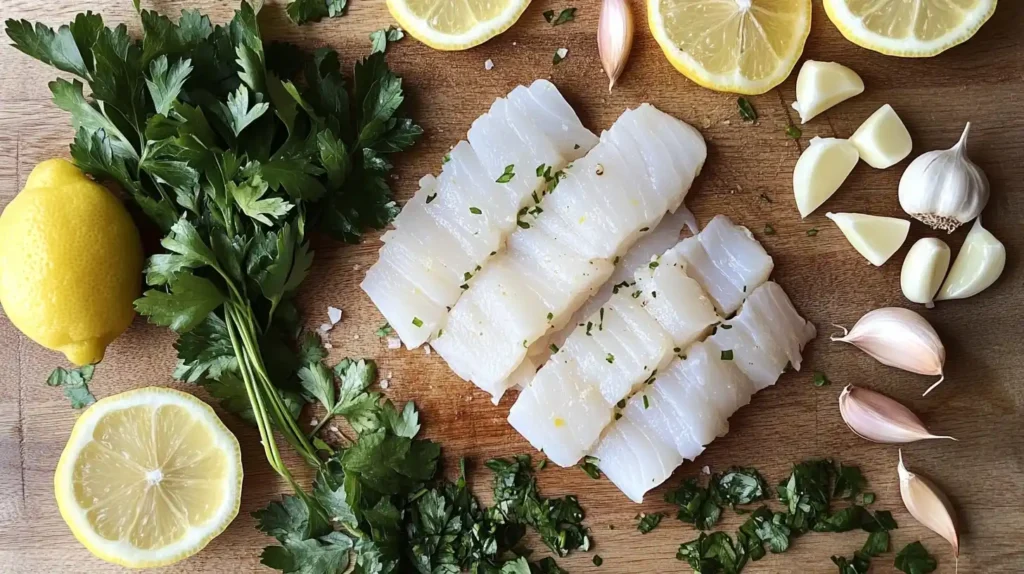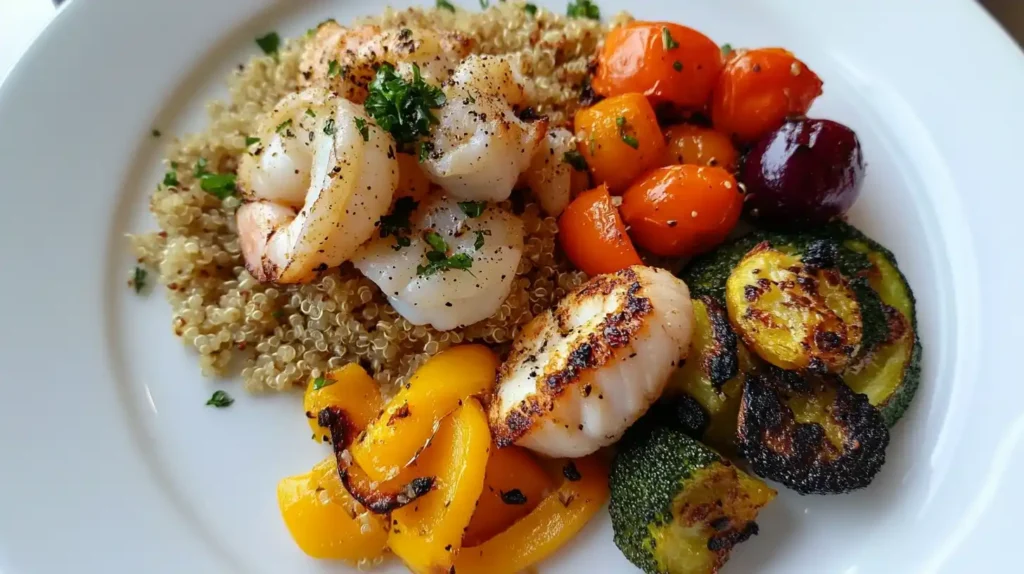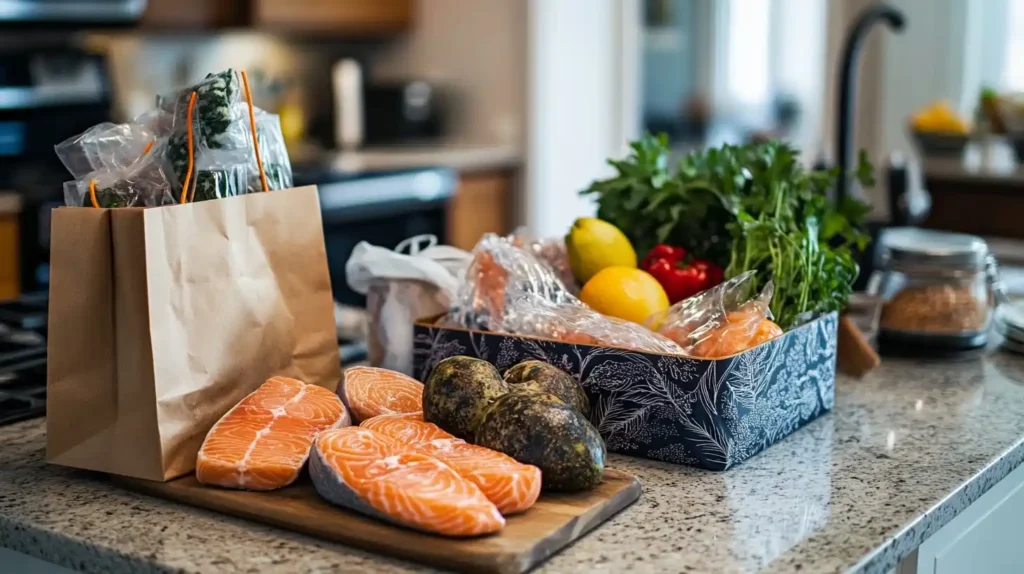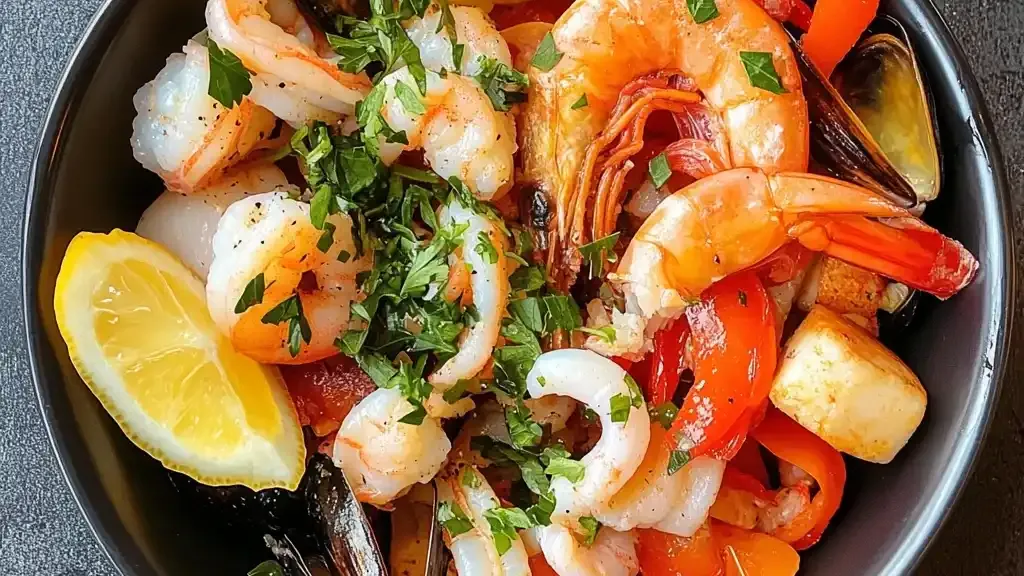If you’re looking for a versatile, healthy, and delicious ingredient, seafood mix is the perfect choice. It brings together various seafood, including shrimp, squid, scallops, and mussels, in one convenient package. This makes it ideal for a variety of meals, from stir-fries to pasta dishes Additionally, seafood mix is rich in essential nutrients, including omega-3 fatty acids, which support heart and brain health.

What is Seafood Mix?
Seafood mix is a combination of different seafood, typically pre-packaged for convenience. It’s perfect for those looking to whip up quick and nutritious meals. Whether you’re a fan of stir-fries or soups, it can fit seamlessly into your cooking routine.
Among the various seafood options, lobsters are a popular choice, known for their rich flavor and tender meat. If you’ve ever wondered about their anatomy, Do Lobsters Have Claws or Pinchers? explores the differences and functions of their claws. Understanding more about seafood can help you appreciate the variety and flavors that seafood mix brings to your dishes.
Key Points:
- Why use seafood mix? It’s versatile and works in countless dishes like stir-fries, soups, and pastas.
- Who is it for? It’s perfect for anyone looking to make quick, nutritious meals.
- What’s in it? The specific combination of seafood may vary, but most mixes are rich in flavor and texture.
For instance, frozen seafood mix is ideal for busy cooks, while fresh options may appeal to those who prefer to shop daily.
Types of Seafood Found in Seafood Mix
A typical seafood mix includes a combination of different seafood varieties. These blends offer diverse textures and flavors, making them a favorite for home cooks and chefs alike.
Common Types:
- Shrimp:
Shrimp are small, flavorful, and quick to cook. They’re a great source of protein and low in calories. Shrimp also pair well with various seasonings, making them a versatile choice. - Squid (Calamari):
Squid, often included in rings or slices, has a mild taste and a slightly chewy texture. It’s delicious when sautéed or deep-fried. - Scallops:
Scallops are buttery, sweet, and tender. They are excellent for pan-searing or adding to creamy dishes. - Mussels or Clams:
These shellfish bring a briny, ocean-like flavor to the mix. They’re rich in iron and other minerals, adding a nutritional boost to any dish.
Why These Varieties Matter
Every seafood variety in the mix adds its own unique flavor and texture. For example, shrimp and scallops add sweetness, while squid and mussels provide a subtle ocean flavor. This variety allows you to create dishes with layers of taste and texture.
Nutritional Benefits of Seafood Mix
One of the greatest advantages of using seafood mix is its impressive nutritional value. Each component in the mix contributes essential nutrients that promote overall health and well-being.

Key Nutritional Benefits:
- Rich in Omega-3 Fatty Acids
Omega-3s are well-known for their heart and brain health benefits. They help reduce inflammation, improve heart function, and may even enhance cognitive performance. This makes it a smart choice for a balanced diet. - High-Quality Protein
Seafood mix is an excellent source of lean protein, which is essential for muscle repair and growth. It’s also low in calories, making it a great option for those aiming to maintain a healthy weight. - Packed with Vitamins and Minerals
- Vitamin D: Supports strong bones and immune health.
- Iodine: Helps regulate thyroid function.
- Selenium: An antioxidant that helps protect cells from damage.
Packed with protein and omega-3 fatty acids, it promotes heart health and muscle growth. It’s also low in calories, making it ideal for maintaining a healthy weight.
Why It’s a Healthy Choice
By including it in your diet, you’re not just enjoying great taste but also boosting your intake of essential nutrients. For more on the benefits of omega-3s, visit the Harvard School of Public Health.
Transitioning to a Seafood-Rich Diet
Switching to meals that include seafood mix is easy. Keeping frozen or fresh options on hand makes it simple to whip up a healthy, nutrient-packed dish in minutes. Additionally, the variety in the mix ensures you won’t get bored with your meals.
How to Cook Seafood Mix
Cooking it is quick and straightforward, making it perfect for busy weeknights or last-minute meals. The blend’s versatility allows you to experiment with various cooking methods while preserving its delicate flavors.

Popular Cooking Methods
- Sautéing
Sautéing is one of the easiest and fastest ways to prepare seafood mix.- Steps to follow:
- Heat butter or olive oil in a pan over medium-high heat.
- Add the thawed seafood mix and cook for 4–5 minutes, stirring occasionally.
- Season with garlic, salt, and your choice of spices.
- Why sautéing works well: This method enhances the natural flavors without overpowering them.
- Steps to follow:
- Steaming
Steaming is a gentle cooking method that retains nutrients and moisture.- Steps to follow:
- Use a steaming basket and place it over boiling water.
- Add the seafood mix and cover with a lid.
- Steam for 5–7 minutes or until the seafood turns opaque.
- Tips: Add herbs or citrus slices to the water for extra flavor.
- Steps to follow:
- Grilling
Grilling gives the seafood mix a smoky, charred flavor that’s hard to resist.- Steps to follow:
- Thread the seafood onto skewers to prevent small pieces from falling through the grill grates.
- Brush with olive oil and season lightly.
- Grill for 2–3 minutes per side over medium heat.
- Why you’ll love it: Grilling brings out the seafood’s natural sweetness.
- Steps to follow:
- Baking
Baking is ideal for creating creamy, comforting dishes.- Steps to follow:
- Preheat the oven to 375°F (190°C).
- Place the seafood mix in a baking dish with a sauce or marinade.
- Cover with foil and bake for 15–20 minutes.
- Suggestions: Try combining seafood mix with a garlic cream sauce or a tomato-based mixture.
- Steps to follow:
Enhancing Flavors with Seasonings
While seafood mix has a mild, natural taste, you can elevate it with a few simple additions:
- Garlic and lemon for a zesty, fresh flavor.
- Smoked paprika or cayenne for a spicy kick.
- Herbs like parsley, dill, or thyme for earthy notes.
Time-Saving Tip: Frozen Seafood Mix
If you’re using frozen seafood mix, remember to thaw it properly. Place the frozen seafood in a bowl of cold water for 10–15 minutes or defrost it overnight in the fridge. This ensures even cooking and prevents the seafood from becoming rubbery.
Recipes Using Seafood Mix
It is a versatile ingredient that fits seamlessly into a variety of dishes. Whether you’re preparing an elegant dinner or a quick meal, it can elevate the flavor and nutrition of any recipe. Let’s explore some popular options.
1. Seafood Stir-Fry
A seafood stir-fry is a fast and flavorful way to enjoy your seafood mix.
- Ingredients:
- 1 lb of seafood mix (thawed)
- 2 tablespoons of soy sauce
- 1 tablespoon of sesame oil
- Mixed vegetables (e.g., broccoli, bell peppers, snap peas)
- 1 teaspoon minced garlic
- Steps to prepare:
- Heat the sesame oil in a wok or skillet over medium-high heat.
- Add the vegetables and sauté for 3–4 minutes.
- Toss in the garlic and seafood mix; cook until the seafood turns opaque (around 5 minutes).
- Stir in the soy sauce and cook for an additional minute.
- Serve hot with steamed rice or noodles.
2. Creamy Seafood Pasta
This rich and satisfying dish is perfect for weeknights or special occasions.
- Ingredients:
- 1 lb of seafood mix (thawed)
- 8 oz of pasta (e.g., linguine or fettuccine)
- 1 cup of heavy cream
- 2 tablespoons of grated Parmesan cheese
- 2 teaspoons minced garlic
- 1 tablespoon olive oil
- Steps to prepare:
- Cook the pasta according to package instructions; set aside.
- Warm olive oil in a skillet over medium heat. Add garlic and sauté until fragrant.
- Stir in the seafood mix and cook for 4–5 minutes.
- Pour in the cream and let it simmer for 2–3 minutes.
- Add Parmesan cheese and toss the pasta in the sauce. Serve warm.
3. Seafood Chowder
Warm and hearty, this chowder is ideal for colder days.
- Ingredients:
- 1 lb of seafood mix (thawed)
- 2 cups of diced potatoes
- 1 cup of diced celery
- 1 cup of diced onions
- 2 cups of milk
- 2 tablespoons of butter
- Steps to prepare:
- Melt the butter in a large pot over medium heat. Add the onions and celery; sauté until soft.
- Stir in the potatoes and pour in enough water to cover them. Simmer until the potatoes are tender.
- Add the seafood mix and cook until opaque (about 5 minutes).
- Pour in the milk, season with salt and pepper, and simmer for another 3–4 minutes. Serve hot.
Why Seafood Mix Recipes Are Special
These recipes are both simple to prepare and full of flavor and nutrition. Additionally, it works well with various cuisines, allowing you to experiment with Asian, Mediterranean, or Latin-inspired dishes.
Avoiding Common Cooking Mistakes
Cooking it can be incredibly rewarding, but there are a few common pitfalls to avoid. By steering clear of these mistakes, you’ll ensure your dishes turn out flavorful and perfectly cooked every time.
1. Overcooking the Seafood
- Why it happens:
Seafood cooks quickly, and leaving it on the heat for too long can cause it to become rubbery or tough. - How to avoid it:
- Watch your seafood closely while cooking.
- Remove it from the heat as soon as it turns opaque and firm.
- Use a timer for recipes to ensure precise cooking times.
2. Improper Thawing
- Why it matters:
Cooking seafood mix straight from the freezer can result in uneven cooking, with some pieces remaining cold or undercooked. - How to thaw properly:
- Submerge the frozen seafood mix in a bowl of cold water for 10–15 minutes.
- Alternatively, leave it in the refrigerator overnight.
- Avoid thawing at room temperature to prevent bacterial growth.
3. Underseasoning the Dish
- Why it happens:
Seafood has a delicate flavor, and some cooks hesitate to add enough seasoning. - How to avoid it:
- Use complementary ingredients like garlic, lemon, herbs, or spices.
- Taste as you cook to adjust the seasoning.
- Balance bold flavors like smoked paprika or cayenne with fresh herbs like parsley or dill.
4. Adding Too Much Liquid
- Why it’s a problem:
Seafood can release moisture during cooking, and adding too much liquid can lead to steaming instead of sautéing or grilling. - How to prevent it:
- Dry the seafood mix thoroughly with a paper towel before cooking.
- Use moderate amounts of oil or sauce.
- Drain excess liquids from the pan as needed.
Quick Fixes for Common Errors
If your seafood turns out overcooked or bland, don’t worry! Here are a few tips to salvage your dish:
- Add a rich sauce like garlic butter or cream to soften the texture.
- Sprinkle fresh herbs or a squeeze of lemon to enhance the flavor.
- Incorporate the seafood into another dish, such as a stir-fry or soup.
By keeping these tips in mind, you can avoid common issues and create restaurant-quality dishes at home.
Choosing and Storing Seafood Mix
Selecting the right seafood mix and storing it properly are crucial for maintaining its quality and flavor. Here’s how to make the best choices and keep your seafood fresh.

How to Choose the Best Seafood Mix
- Fresh vs. Frozen Options
- Fresh Seafood Mix:
- Ideal for immediate use.
- Look for clear packaging and seafood with a fresh, ocean-like smell.
- Frozen Seafood Mix:
- Convenient and long-lasting.
- Check for minimal ice crystals, as they indicate better freezing quality.
- Fresh Seafood Mix:
- Read the Labels
- Look for certifications like MSC (Marine Stewardship Council) or ASC (Aquaculture Stewardship Council) for sustainably sourced seafood.
- Avoid mixes with excessive additives or preservatives.
- Check for Variety
- Opt for a mix that includes shrimp, scallops, squid, and mussels for a balance of flavors and textures.
- Be mindful of any allergens or preferences when selecting the mix.
How to Store Seafood Mix
- Short-Term Storage
- If using fresh seafood, keep it in the refrigerator at 32°F (0°C).
- Use within 1–2 days to maintain freshness.
- Freezing for Long-Term Use
- Seal the seafood mix in an airtight container or freezer bag.
- Label it with the date and use it within 2–3 months for optimal quality.
- Thawing Safely
- Thaw the mix in the refrigerator overnight or in cold water for faster results.
- Avoid microwaving, as it can unevenly cook parts of the seafood.
Tips for Maintaining Quality
- Avoid Refreezing: Once thawed, refreezing seafood can compromise its texture and taste.
- Store Away from Strong Odors: Seafood can absorb nearby smells, so keep it separate from strong-smelling foods like onions or garlic.
- Check Expiry Dates: Always check the “use by” date on packaging to ensure freshness.
Sustainable Choices Matter
Choosing sustainable seafood not only benefits the environment but also ensures you’re supporting ethical fishing practices. The Sustainable Seafood Guide provides valuable resources to help you make eco-friendly decisions.
By following these guidelines, you’ll always have fresh, flavorful seafood mix ready to transform into delicious meals.
FAQs About Seafood Mix
Here are answers to some of the most frequently asked questions about it. These insights will help you use this ingredient effectively while ensuring your dishes turn out perfectly every time.
1. Can You Cook Frozen Seafood Mix Without Thawing?
Yes, you can cook frozen it directly, but thawing is recommended for better results. Cooking frozen seafood may result in uneven cooking since some pieces will take longer to cook than others.
- Best practice: Thaw your seafood mix in the refrigerator or in a bowl of cold water for 10–15 minutes.
2. How Do You Know When Seafood Mix Is Fully Cooked?
Cooked seafood turns opaque and firms up. Overcooking should be avoided, as it can make the seafood rubbery.
- Tips for timing:
- Shrimp: 3–5 minutes.
- Scallops: 4–6 minutes.
- Squid: 2–3 minutes (quick cooking ensures tenderness).
3. What Are Some Kid-Friendly Recipes Using Seafood Mix?
Getting kids to enjoy seafood can be fun with the right recipes. Here are a few ideas:
- Seafood Tacos: Use soft tortillas, mild seasonings, and a creamy sauce.
- Seafood Pasta: Combine it with a cheesy sauce for a kid-approved dish.
- Mini Seafood Pizzas: Add it to personal-sized pizzas with a light marinara sauce.
4. How Long Can You Store Cooked Seafood Mix?
Cooked seafood mix can be stored in the refrigerator for up to three days. Always use a sealed container to maintain freshness.
- Reheating tips:
- Use a microwave on low power to prevent overcooking.
- Alternatively, reheat in a skillet with a splash of water or sauce for added moisture.
5. Is Seafood Mix a Good Option for Meal Prep?
Absolutely! it is ideal for quick, healthy meals throughout the week. Its versatility allows you to use it in various dishes, so you won’t get bored with your menu.
- Meal prep ideas:
- Prepare a big batch of stir-fry or pasta for lunches.
- Use it as a protein topping for salads or grain bowls.
Bonus Tip: Making Seafood Mix More Flavorful
If you find pre-packaged seafood mix bland, marinate it before cooking. Simple marinades like lemon juice, olive oil, garlic, and herbs can elevate the flavors significantly.
Conclusion
Incorporating seafood mix into your meals is a simple and delicious way to add variety and nutrition to your diet. With its combination of shrimp, scallops, squid, and other seafood, it offers a balance of flavors and textures that can enhance any dish. Whether you’re preparing a quick stir-fry, a creamy pasta, or a hearty soup, seafood mix delivers convenience and health benefits in every bite.
Why Choose Seafood Mix?
- Versatility: Works well in diverse cuisines like Mediterranean, Asian, and Latin-inspired dishes.
- Nutrition: Packed with protein, omega-3s, and essential vitamins for a healthier lifestyle.
- Convenience: Pre-packaged and ready to use, saving you time in the kitchen.
Final Tips for Success
To make the most of your seafood mix:
- Always thaw it properly for even cooking.
- Use simple seasonings to complement its natural flavors.
- Experiment with different cooking methods to keep your meals exciting.

